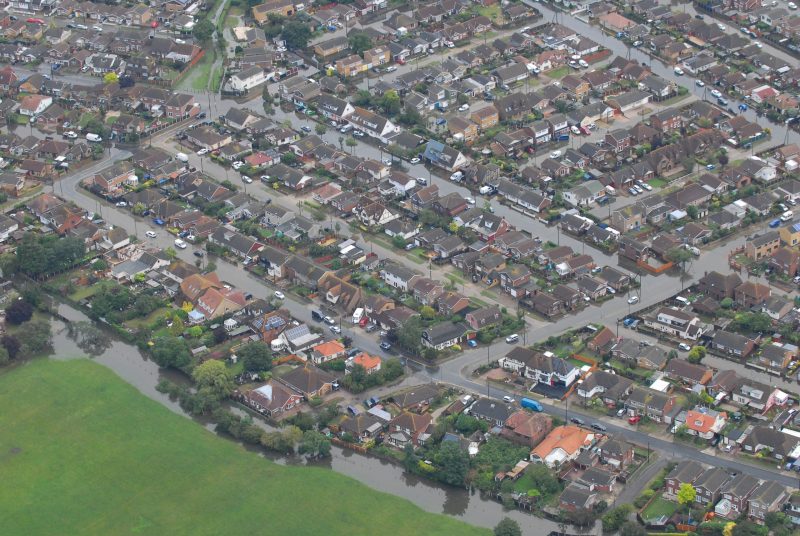Canvey Island residents invited to shape flood risk management
 Date of release: September 6
Date of release: September 6
Are you a Canvey Island resident frustrated by regular flooding incidents? Would you like to help map out the problems and co-create the solutions? Then an innovative new community project wants to hear from you.
Environmental charity Thames21, which has vast experience galvanising London communities on waterways issues, is leading an innovative two-year project in the area.
The Canvey Island project is one of eight Building Resilience in Flood Disadvantaged Communities (BRIC) pilots across the UK and France.
Traditionally, flood risk management is led by councils and water authorities in a “top down” approach. From the public’s point of view, progress to solutions can seem slow.
The BRIC programme is designed to change all that by giving residents a direct say. It will empower individuals and community groups to share responsibility for flood risk management issues more equally with the authorities that oversee them.
The €3.4m BRIC programme includes €2.36m from the Interreg France Channel England Fund. Work is taking place at eight pilot areas: Plymouth, Dorset, Canvey and Kent in England and at Oise, Eure, Val d’Authie and Finistere in northern France. The aim of the programme is to create a guide, new tools and resources that can be used more widely in areas affected by flooding across the UK and France.
Canvey Island has been chosen because it is highly vulnerable to flooding from surface water, with climate change an increasing issue.
Set on the South East coast of Essex in the Thames estuary, Canvey Island was the fastest growing seaside resort in the UK in the first half of the 20th Century. But it was devastated by floods in 1953.
Now largely protected from tidal surges by its sea wall, the area has suffered from extensive surface water flooding a number of times in recent years, as a result of heavy rainfall and poor drainage. With extreme weather events linked to climate change and major flooding incidents such as in 2014, 2016 and 2018 likely to be repeated if the situation is not addressed, the project will focus on future proofing the area.

Thames21 will facilitate training and work with residents to map out local flood issues and possible solutions, as well as to create new flood resilience ambassadors. The charity will support residents to collaborate with flood risk management organisations such as Anglian Water, Castle Point Borough Council, Essex County Council and the Environment Agency.
Residents are invited to meet Thames21’s engagement officers Kate Monson and Lauren Hollas to learn how they can get involved. They will be at the Knightswick Shopping Centre Market on Thursday 16th September and at the Canvey Island Town Council offices on Thursday 14th October, both between 10am and 3pm.
Elaine De Can, Town Clerk at Canvey Island Town Council, said: “The BRIC project is a great initiative and an opportunity for Canvey residents and community groups to have an input into building resilience against the island’s flooding issues.”
Debbie Leach, CEO at Thames21, said: “Flooding can have a devastating impact on communities. We are delighted to have this chance to use our extensive experience working in communities to help Canvey Island’s residents come together, map out the problems and co-design solutions with those who provide flood risk management services.”
Carolyn Reid, Programme Manager, Interreg France (Channel) England, said: “The damage caused by flooding has a huge cost and social impact on communities in the Channel area.
“Through funding this project, we seek to support new approaches to flood management which will help communities adapt to climate change and build local resilience. Importantly, solutions will be developed in consultation with local citizens, including with the most vulnerable groups, and with a focus on future proofing.”
For more information about the project, visit our BRIC webpage.
Notes for editors
About Thames21
Thames21 connects people with rivers by putting healthy rivers back at the heart of everyday life. We improve and restore rivers, educate and empower the community and campaign for positive change for the good of people and the environment.
www.thames21.org.uk | Registered Charity No. 1103997
Follow up interviews are available with Chris Coode, Deputy CEO of Thames21 and head of engagement and education.
About the Interreg FCE programme
Interreg France (Channel) England (FCE) is an EU programme set up to foster economic development in the south of the UK and north of France by funding innovative projects which have a sustainable and economic benefit. It focuses on a range of specific objectives including supporting innovation, improving the attractiveness of the FCE area and developing low carbon technologies.
More information: www.channelmanche.com
Organisations which have been given funding by the Interreg France-Channel-England programme for BRIC include:
- Plymouth City Council. Unitary authority incorporating strategic planning, parks and highways maintenance and Lead Local Flood Authority.
- National Flood Forum. Representing communities at risk of flooding, and supporting self help through formation of flood action groups.
- Dorset County Council / Dorset Coastal Forum. Lead Local Flood Authority, and Forum to foster collaboration between coastal stakeholders
- A Rivers Trust, covering the lower Thames, in London and its tidal reaches. Working to improve rivers, connect communities, and provide training.
- Cerema (Centre d’études et d’expertise sur les risques, l’environnement, la mobilité et l’aménagement). A national agency providing advice and support
- regarding a wide range of environmental issues, including flood risk management and urban design.
- L’Oise La Vallee (Agence d’Urbanisme et de Développement de la Vallée de l’Oise). An urban planning agency, providing services on-demand to Communes in Vallee de L’Oise
- CPIE d’Authie (Centre Permanent d’initiatives pour, l’environment d’Authie). An environmental and community education NGO.
- OGoXe. A tech company providing flood warning and environmental monitoring services.
- Flooding costs France and England about €870m annually. This figure is expected to rise by 25-80% by 2100. In addition, projected sea level rises resulting from climate change threatens more than 100,000 buildings in the France (Channel) England area.
Media Contact
Ian Lamont
Communications at Thames21
07711 701 696
020 7248 7171
